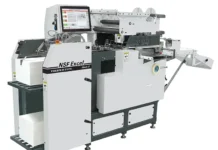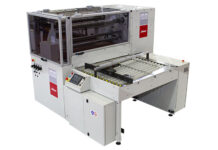Edited by Erin La Row, editor, PostPress
Scodix Inc., with US headquarters in Saddle Brook, New Jersey, has released two technological breakthroughs for digital embellishments that offer finer detail and a wider range of usable substrates: Scodix Smart High Definition (SHD) and Scodix Anti-Static
Reflective & Transparent (ART).
Scodix SHD
Scodix SHD gives users the ability to achieve quality and detail that rivals conventional foil stamping and can be applied underneath lamination.
“Scodix SHD tops off our offerings, giving customers more effects in a single platform than any competing technology on the market today,” said Paul Furse, director of channel sales, Americas. The ‘Smart’ in Smart High Definition utilizes a unique artificial intelligence to identify fine lines and edges of objects to both reduce polymer consumption as well as produce the same flawless appearance as could be expected from analog methods. Furse said what this means for customers is finer detail at a lower cost.
Scodix ART
Scodix ART expands the gamut of usable substrates by opening up synthetics and thick laminates (anti-static); reflectives, such as foil board, metallic laminates or substrates that already are metalized in some way; and synthetic transparent (clear) medias.
“With Scodix ART, customers can utilize Scodix embellishment technologies as they would any other substrates in the production process when using medias that would be exceptionally laborious to impossible with other digital embellishment technologies or conventional stamping methods,” Furse said.
Overcoming challenges
Because of the heat, pressure and overall process of conventional analog stamping technologies, Furse said it is exceptionally challenging to hot foil stamp both small text or
thin lines as well as large surface areas in a single run.
“With digital embellishment technologies, this has been virtually impossible, requiring multiple passes as well as additional polymer and foil usage to ‘balance’ the sheet, with hours of set-up to even attempt it. Scodix SHD uniquely offers the ability to do fine lines and large solids both in a single pass on both B1 & B2+ sheets, at a lower cost than historical digital embellishments,” he added.
Scodix SHD produces high-margin work in print economically, productively and sustainably through minimal polymer usage, no dies, plates or screens and with significantly reduced set-up and run times. Working with plastics and PVCs is challenging, and working with transparencies can be even more challenging. Adding conventional embellishments to metalized surfaces is common but challenging for digital systems because of reflectivity back into optical sensors, cameras or scanners.
“Scodix has developed a unique sensor system that, when combined with our existing encoder and registration technologies, can achieve the same industry-leading registration accuracy our customers trust and respect on these challenging materials,” Furse said. “This
opens the gamut of usable substrates in the digital process. It’s a big win for our customers and for the industry as a whole.”
Both Scodix SHD and Scodix ART are available with new Scodix Ultra presses, and Furse said there are options for legacy customers to upgrade older presses.
Customer response
According to Furse, Scodix ART officially launched in January 2024, and customers already utilizing this technology have shown that productivity of what were challenging medias has skyrocketed. Plastics and metalized substrates now are being run like any other conventional media in the production process.
Furse said that all Scodix 6000s, the company’s flagship B1 press, sold in the past 12 months have been purchased with Scodix SHD, and many companies have upgraded to the
technology. Additionally, part of the technology behind Scodix SHD is a newly developed polymer that replaces three historically used Scodix polymers.
“For our most versatile customers, we’ve eliminated what may have been three changeovers, once again leading to even higher productivity, higher sustainability and lower economics,” Furse said





